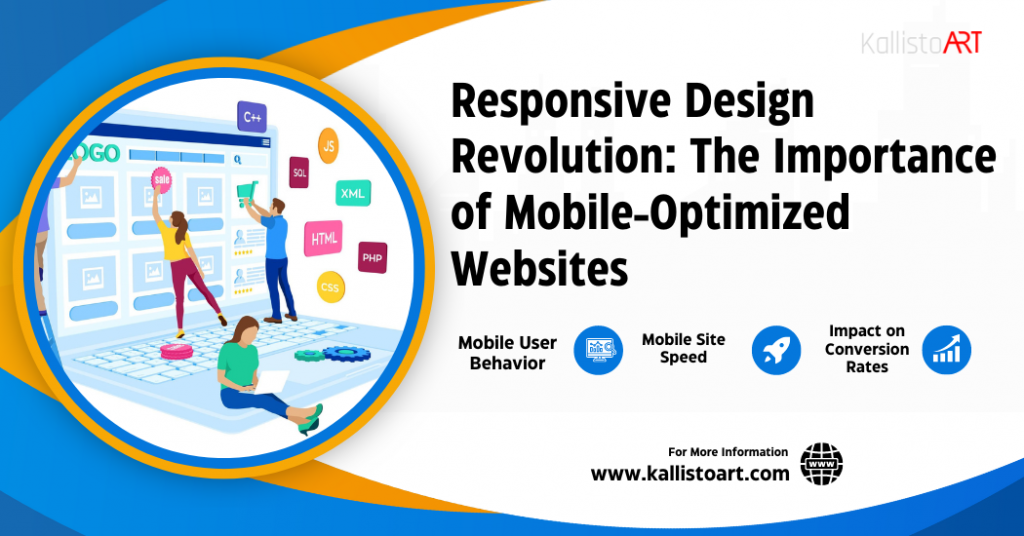The Importance of a Mobile-Friendly Website – KallistoArt
Introduction
In the vibrant digital landscape of Tampa, Florida, where businesses strive to make their mark, the role of a well-crafted website cannot be underestimated. As users increasingly turn to their mobile devices for online interactions, the importance of a mobile friendly website is heightened for businesses seeking a competitive edge. In this article, we delve into the pivotal aspects of mobile-friendly web design, exploring why it is not just a necessity but a strategic imperative for businesses, including those in the thriving city of Tampa.
A. Definition and significance of mobile-friendly websites
In the heart of Tampa’s bustling business scene, a mobile-friendly website refers to a digital platform that is meticulously designed to offer an optimal and seamless experience for users accessing it through mobile devices such as smartphones and tablets. For a Web design company in Tampa, understanding the significance of mobile-friendly websites is paramount. It’s not merely about keeping up with trends; it’s about meeting the evolving expectations of users in a city known for its tech-savvy and digitally engaged community.
B. Evolution of mobile usage trends
As Tampa’s population embraces the mobile revolution, businesses find themselves at a crucial crossroads. The evolution of mobile usage trends signifies a shift in consumer behavior, with more individuals relying on their smartphones to explore local services, including those provided by a Web design company. Navigating this evolution requires a proactive approach to mobile-friendly web design, aligning with the changing habits of the city’s diverse and dynamic audience.
Mobile User Behavior
Mobile user behavior plays a pivotal role in shaping the digital landscape, influencing how individuals interact with content and businesses on the internet. Understanding the intricacies of how users behave on mobile devices is crucial for crafting effective strategies to engage and retain this growing audience.
A. Statistics on Mobile Internet Usage
Recent statistics paint a vivid picture of the dominance of mobile internet usage in today’s connected world. According to industry reports, the majority of internet users access online content through mobile devices. The trend is particularly pronounced among younger demographics, highlighting the need for businesses to prioritize mobile optimization.
Key statistics include:
- Global Mobile Users: Over 3.7 billion people worldwide use smartphones, showcasing the vast potential audience for mobile-optimized content.
- Mobile vs. Desktop Usage: Mobile devices have surpassed desktops in terms of internet usage, with a significant shift towards on-the-go access.
- App vs. Browser Usage: The prevalence of mobile apps is noteworthy, indicating a preference for app-based experiences alongside traditional browser usage.
Understanding these statistics is instrumental in recognizing the ubiquity of mobile devices in users’ lives and the imperative for businesses to adapt their online presence accordingly.
B. Impacts of Mobile User Experience on Website Success
The statistics above underscore the significance of considering mobile user experience as a critical factor in the success of a website. User experience (UX) on mobile devices directly influences user satisfaction, engagement, and ultimately, the success of online ventures.
- User Expectations: Mobile users have distinct expectations regarding speed, convenience, and responsiveness. Slow-loading websites or those with a subpar user interface risk losing user interest rapidly.
- Responsive Design: Websites that seamlessly adapt to various screen sizes through responsive design garner positive feedback. Conversely, sites that require excessive zooming or scrolling may frustrate users.
- Engagement Metrics: Metrics such as bounce rates and average session durations are directly affected by mobile user experience. A positive experience encourages prolonged engagement, leading to higher chances of conversions.
- Brand Perception: A poorly optimized mobile experience can harm a brand’s perception. Users may associate a frustrating mobile interaction with the overall quality and credibility of a business.
To succeed in the digital landscape, businesses must not only acknowledge the prevalence of mobile users but prioritize creating a positive and intuitive experience tailored to the unique characteristics of mobile devices.
Get the best mobile-friendly website today. Elevate your user experience and boost visibility. Let’s make your website shine on every device! Contact us now.
Search Engine Optimization (SEO) Benefits
A. Google’s Mobile-First Indexing
In the ever-evolving landscape of online search, Google, being the dominant search engine, continually refines its algorithms to enhance user experience. One such significant shift is the adoption of mobile-first indexing.
What is Mobile-First Indexing? Google’s mobile-first indexing means that the search engine primarily uses the mobile version of a website’s content for indexing and ranking. This approach reflects the growing trend of users accessing the internet via mobile devices.
Impact on Search Rankings: We delve into how this shift influences search rankings. Websites that prioritize mobile-friendliness receive preferential treatment in search results. Google identifies and rewards mobile-friendly sites with higher visibility, leading to increased organic traffic.
B. Improved Search Rankings for Mobile-Friendly Sites
The correlation between mobile-friendliness and search rankings is not merely coincidental; it is rooted in user-centricity.
User Experience and Dwell Time: Google places a strong emphasis on user experience. Mobile-friendly sites provide a seamless and enjoyable experience for users on smaller screens. This positive experience leads to increased dwell time — the duration users spend on a webpage. Google interprets longer dwell times as a signal of content relevance and quality, thereby boosting the site’s ranking.
Reduced Bounce Rates: Mobile optimization contributes to lower bounce rates. When users find a website easy to navigate on their mobile devices, they are more likely to explore multiple pages. Reduced bounce rates send positive signals to search engines, indicating that the content aligns with user intent.
Local SEO Advantage: For businesses with a local presence, mobile-friendliness is integral to local SEO. Google prioritizes local results for mobile users, making mobile optimization a crucial factor for appearing in local search queries.
Competitive Edge: In an era where competition for online visibility is fierce, having a mobile-friendly website is a competitive differentiator. Google rewards sites that cater to the preferences of its users, making mobile optimization a strategic advantage.
Key Takeaways
- Adaptation to User Behavior: Recognizing and adapting to the way users access information is fundamental. With the majority of searches happening on mobile devices, aligning your website with these user behaviors is essential for SEO success.
- User-Centric Design: Google’s algorithms prioritize websites that prioritize users. By creating a mobile-friendly design, you signal to search engines that your site is committed to delivering an optimal user experience.
- Strategic SEO Investment: Investing in mobile optimization is not just a trend; it’s a strategic SEO investment. It pays dividends in terms of improved search rankings, increased organic traffic, and a competitive edge in the digital landscape.
Responsive Design
In the ever-expanding landscape of digital devices, ensuring that your website looks and functions seamlessly across various screen sizes is paramount. This is where responsive design comes into play. It’s not just a buzzword; it’s a fundamental approach to web design that prioritizes user experience on devices of all shapes and sizes.
A. Explanation of responsive web design
Responsive web design is an approach to designing and coding a website that ensures optimal viewing and interaction experiences across a range of devices, from desktop computers to smartphones and tablets. The primary goal is to create a flexible and fluid layout that adapts to the user’s screen size, providing a consistent and enjoyable experience.
Key Components of Responsive Design:
- Fluid Grids: Instead of fixed pixel values, responsive design uses relative units like percentages for widths. This allows the layout to adapt proportionally to the screen size.
- Flexible Images: Images within a responsive design are also sized in relative units, preventing them from overflowing or shrinking disproportionately on different devices.
- Media Queries: CSS media queries are used to apply different styles or rules based on the characteristics of the device, such as screen width, height, or resolution.
- Viewport Meta Tag: The viewport meta tag is crucial for responsive design, as it controls how the website is displayed on a device. It ensures that the content scales properly to fit the screen.
B. Advantages and drawbacks of responsive design
Advantages:
- Enhanced User Experience: Users can seamlessly navigate and interact with the website, regardless of the device they are using.
- Cost-Effective: Instead of creating separate websites for different devices, responsive design allows for a single design and codebase, reducing development and maintenance costs.
- Improved SEO: Google favors mobile-friendly websites. Responsive design contributes to better search engine rankings, as Google’s algorithms prioritize mobile-friendly content.
- Easier Maintenance: With a single codebase, updates and changes can be implemented more efficiently, ensuring consistency across all devices.
Drawbacks:
- Performance Considerations: Depending on the complexity of the design and content, a responsive website might load more slowly on mobile devices. Optimizing performance is crucial.
- Complexity in Implementation: Implementing a responsive design can be more complex than creating a static website. Careful planning and testing are essential.
- Limited Control: Designers may face limitations in achieving a highly customized look for different devices due to the need for flexibility and adaptability.
- Learning Curve: For developers new to responsive design, there may be a learning curve associated with mastering the intricacies of fluid layouts and media queries.
In essence, responsive design is a cornerstone of mobile-friendly web development. It’s not just a trend but a necessity in a world where users access websites on an array of devices. By adopting responsive design principles, businesses can ensure that their online presence remains accessible and enjoyable for users, regardless of the device they choose. It’s a strategic move that aligns with the evolving expectations of a diverse and mobile-centric audience.
VI. User Experience (UX) Design
In the realm of mobile-friendly websites, User Experience (UX) Design takes center stage. It’s not merely about aesthetics but about crafting an experience that captivates and satisfies visitors. In this section, we explore the key elements of mobile-friendly UX and provide real-world examples of successful mobile UX designs.
A. Key elements of mobile-friendly UX
1. Responsive Layouts:
Why it matters: Responsive layouts ensure that your website adapts seamlessly to different screen sizes. A user accessing your site on a smartphone should have an experience as smooth as someone using a desktop.
Considerations: Prioritize flexible grids and images, allowing content to maintain its integrity across various devices.
2. Intuitive Navigation:
Why it matters: Users should effortlessly navigate your site without confusion. Clear menus, easily accessible buttons, and logical pathways enhance the overall user experience.
Considerations: Implement a user-centric navigation structure, minimizing clicks to reach essential pages and ensuring a streamlined flow.
3. Touch-Friendly Design:
Why it matters: Mobile users interact with screens through touch. Designing touch-friendly elements, like buttons and links, contributes to a positive and frustration-free experience.
Considerations: Ensure touch targets are appropriately sized, avoiding overcrowding and reducing the chance of accidental clicks.
4. Fast Loading Speed:
Why it matters: Users on mobile devices expect speed. A slow-loading site can lead to high bounce rates and a negative perception of your brand.
Considerations: Optimize images, leverage browser caching, and prioritize critical content to ensure swift loading times.
5. Readable Typography:
Why it matters: Legible text is paramount. Mobile devices come in various sizes, so using readable font sizes and styles ensures content remains accessible.
Considerations: Test font choices on different devices to guarantee readability. Aim for a clean and consistent typography style.
In crafting a mobile-friendly website, incorporating these key UX design elements ensures that users not only stay on your site but enjoy a positive and memorable experience. Mobile UX goes beyond aesthetics; it’s about creating an environment where users feel valued and can seamlessly achieve their goals. As you embark on optimizing your website for mobile, keep these UX principles in mind, and let user satisfaction guide your design decisions.
Impact on Conversion Rates
In the dynamic landscape of online business, conversion rates stand as a pivotal metric, directly influencing the success and profitability of a website. Understanding how mobile-friendliness ties into conversion rates is paramount for businesses seeking sustained growth.
A. How mobile-friendliness influences conversions
Mobile-friendliness plays a pivotal role in shaping user behavior, and consequently, it has a profound impact on conversion rates. Let’s explore the key ways in which a mobile-friendly website influences conversions:
1. User Engagement and Trust:
- Mobile users often form their first impressions within seconds. A website that is optimized for mobile not only loads quickly but also provides a seamless and visually appealing experience. This fosters trust and engagement, crucial elements in persuading visitors to convert.
2. Responsive Checkout Process:
- For e-commerce websites, the checkout process is a critical juncture. A mobile-friendly design ensures that the checkout process is smooth, intuitive, and hassle-free. This reduces friction and increases the likelihood of users completing their purchases.
3. Call-to-Action Visibility:
- On smaller screens, the visibility of call-to-action buttons becomes even more crucial. A mobile-friendly design strategically places these elements, making it easy for users to take the desired actions, whether it’s making a purchase, filling out a form, or contacting the business.
4. Page Load Speed:
- Mobile users are often on-the-go and impatient. A mobile-friendly website addresses this by optimizing page load speeds. Faster load times not only enhance the overall user experience but also contribute to higher conversion rates as users are more likely to stay and explore.
5. Cross-Device Consistency:
- With users frequently switching between devices, maintaining a consistent and cohesive user experience across desktop and mobile platforms is essential. A mobile-friendly website ensures that users encounter a seamless transition, contributing to a positive user journey and increased conversions.
B. Case studies showcasing increased conversions
To illustrate the tangible impact of mobile-friendliness on conversion rates, let’s delve into a couple of real-world case studies:
Case Study 1: E-Commerce Overhaul
- An e-commerce platform revamped its website to be mobile-friendly, implementing a responsive design and optimizing the checkout process. The result was a remarkable 25% increase in conversion rates within the first quarter post-implementation.
Case Study 2: Service-Based Business
- A service-based business, after adopting a mobile-first approach to its website, observed a significant reduction in bounce rates and a 20% uptick in conversion rates. The streamlined mobile experience led to more inquiries and form submissions.
In these instances, the correlation between mobile-friendliness and increased conversions is evident. Businesses that prioritize mobile optimization not only enhance user experience but also reap the rewards of higher conversion rates, ultimately impacting their bottom line positively.
Get the best mobile-friendly website today. Elevate your user experience and boost visibility. Let’s make your website shine on every device! Contact us now.
Mobile Site Speed
A. Impact of Site Speed on Mobile Users
In the fast-paced world of the internet, where attention spans are short, the speed at which a website loads plays a pivotal role in user satisfaction. When it comes to mobile users, the importance of site speed is magnified.
1. User Experience Implications
Mobile users expect instantaneous access to information. Slow-loading websites frustrate users, leading to a higher likelihood of abandonment. The impact is not limited to bounce rates; it extends to overall user experience, influencing perceptions of a brand’s reliability and professionalism.
2. Bounce Rates and Conversion Rates
The correlation between site speed and bounce rates is well-established. If your mobile site is slow to load, visitors are more likely to abandon it before exploring any content. This not only affects bounce rates but also has a direct bearing on conversion rates. Users are less likely to convert if they encounter delays in accessing the desired information or completing a transaction.
3. Mobile-First Indexing
With Google’s emphasis on mobile-first indexing, site speed has become a critical factor for search engine rankings. Google prioritizes websites that provide a swift and seamless experience on mobile devices. Therefore, a slow-loading mobile site may not only lose visitors but also suffer in terms of search visibility.
B. Strategies for Improving Mobile Site Speed
Recognizing the significance of site speed for mobile users, it becomes imperative to implement strategies that optimize performance.
1. Optimize Images and Multimedia Content
Large image files and unoptimized multimedia content can significantly contribute to slow page loading times. Compressing images and using efficient multimedia formats are essential steps in reducing load times without compromising visual quality.
2. Minimize HTTP Requests
Each element on a webpage, such as images, scripts, and stylesheets, requires a separate HTTP request. Minimizing the number of requests helps expedite page loading. Techniques like combining CSS and JavaScript files or using image sprites can be employed to achieve this.
3. Implement Browser Caching
Leveraging browser caching allows frequently visited pages to be stored in a user’s browser. Subsequent visits result in faster load times, as the browser retrieves elements from the cache rather than re-downloading them.
4. Enable Compression
Compressing files before they are sent over the network reduces the amount of data transferred. Gzip compression, for instance, can significantly decrease file sizes, resulting in faster loading times.
5. Prioritize Above-the-Fold Content
Loading critical content visible without scrolling first (above-the-fold) prioritizes the user’s immediate needs. Even if the entire page is not loaded instantly, users can access essential information promptly.
6. Utilize Content Delivery Networks (CDNs)
CDNs distribute website content across multiple servers worldwide, allowing users to access data from a server closest to their location. This minimizes latency and contributes to faster loading times.
7. Regular Performance Audits and Monitoring
Regularly assessing your website’s performance through audits and monitoring tools helps identify bottlenecks and areas for improvement. This proactive approach ensures ongoing optimization and a consistently fast user experience.
Social Media and Mobile Compatibility
A. Integrating mobile-friendliness with social media strategies
The intersection of social media and mobile compatibility is a crucial aspect of modern digital marketing. As users increasingly access social platforms via mobile devices, ensuring seamless compatibility becomes imperative for maintaining a strong online presence.
B. Mobile-Optimized Social Media Content
Social media platforms are predominantly accessed through mobile apps, making it vital for businesses to optimize their content for mobile viewing. This involves creating visually appealing and easily digestible content that aligns with the constraints of mobile screens. From images and videos to text-based posts, each element should be crafted with mobile users in mind.
C. Responsive Social Sharing Buttons
One key strategy is the implementation of responsive social sharing buttons on websites. These buttons should be designed to adapt to various screen sizes, facilitating easy sharing of content across different social media platforms. This not only enhances user experience but also encourages social engagement, as users can effortlessly share interesting content with their networks.
Mobile-Friendly Social Advertising
Incorporating mobile-friendly strategies into social advertising is essential for reaching a broader audience. Adapting ad formats to suit mobile screens ensures that promotional content remains visually appealing and doesn’t disrupt the user experience. This can involve utilizing carousel ads, video ads, or other formats optimized for mobile consumption.
Importance for Local Businesses
In the dynamic landscape of digital marketing, local businesses stand to gain significantly from ensuring their websites are mobile-friendly. Let’s explore the nuances of this crucial aspect.
A. Local SEO and Mobile-Friendliness
Local Search Engine Optimization (SEO) is a specialized field that focuses on optimizing a business’s online presence to attract local customers. Mobile-friendliness is a pivotal factor in local SEO, influencing how well a business ranks in local search results.
B. The Impact on Local Search Rankings
Google’s algorithms take into account mobile-friendliness when determining local search rankings. With an increasing number of users conducting local searches on their mobile devices, having a mobile-friendly website becomes instrumental in securing a prominent position in local search results.
C. Location-Based Searches
Mobile users often include location-specific terms in their searches, such as “near me” or the name of a specific locality. A mobile-friendly website ensures that your business appears in relevant local searches, boosting visibility among potential customers in your vicinity.
Conclusion
In conclusion, the importance of a mobile-friendly website cannot be overstated in today’s digital landscape. From influencing search rankings and user experience to impacting conversion rates and local business success, mobile optimization is a strategic imperative. As we look to the future, web design companies in Tampa and beyond must prioritize mobile-friendly practices to ensure their clients’ websites remain competitive, accessible, and responsive to the ever-evolving needs of users in the mobile era.
Frequently Asked Questions:
Q1. How does mobile-friendliness impact search engine optimization (SEO) for websites?
Ans: Mobile-friendliness is a crucial factor in SEO. Search engines, especially Google, prioritize mobile-friendly websites in their rankings. Having a mobile-friendly site enhances your visibility in search results, ultimately driving more organic traffic to your website.
Q2. How does mobile site speed affect user experience?
Ans: Mobile site speed directly affects user satisfaction. Slow-loading sites can lead to high bounce rates, negatively impacting user experience. Fast-loading mobile sites contribute to a positive user experience, keeping visitors engaged and improving overall satisfaction
Q3: What can we expect in terms of future trends in mobile web development?
Ans: Emerging trends include the integration of artificial intelligence, immersive technologies like augmented reality (AR) and virtual reality (VR), and a continued focus on enhancing user experience through innovative design and functionality. Staying updated on these trends is crucial for future-proofing your mobile-friendly website.





